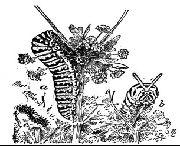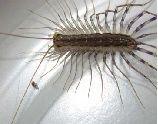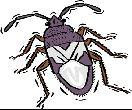Natural Solutions to Things That Bug You (70 page)
Read Natural Solutions to Things That Bug You Online
Authors: Myles Bader

Pyrethrum is a natural botanical poison that will make the larvae so sick that they will leave their webs, pack up and head for greener, safer pastures.

CENTIPEDES
 General Information:
General Information:
 These creepy crawlers can actually have as many as 346 legs and sometimes as few as 30, which will depend on the species. They have a pair of claws that are venomous and can paralyze their victims. These are good to have around the garden, (but will occasionally frequent the house) since they eat snails, slugs, grasshoppers and many other pests. When you find them in the basement or house they are looking for cockroaches, flies and moths.
These creepy crawlers can actually have as many as 346 legs and sometimes as few as 30, which will depend on the species. They have a pair of claws that are venomous and can paralyze their victims. These are good to have around the garden, (but will occasionally frequent the house) since they eat snails, slugs, grasshoppers and many other pests. When you find them in the basement or house they are looking for cockroaches, flies and moths.
The very small centipede-looking bug, that you may see in your garden resembles a white centipede but are really “symphylan.” These can do a great deal of damage to plants and are mainly found in greenhouses in the southwestern states. There is also a species called the “house centipede.”

The house centipede is believed to have originated in the Mediterranean region and was introduced into Mexico and the Southern United States and has increased its distribution.
The first observation of the centipede was first recorded in Pennsylvania in 1849 and today, the house centipede can be found in many buildings throughout the United States. It does not survive winters outdoors in Pennsylvania, but readily reproduces in heated structures.
They are very secretive, have a scary appearance and darting motions, homeowners typically fear the house centipede. The adult centipede has 15 pair of legs with the last pair (on adult females) nearly twice the length of the body, which is about one to one and one-half inches in length. This gives the centipede an overall appearance of being from three to four inches in length (including legs and antennae).
The house centipede’s legs are banded light and dark, and the body is a dirty yellow with three longitudinal, dark stripes. Newly hatched larvae have four pair of legs. During the next five larval molts, the centipedes will have a different number of legs.
On the sixth molt the centipede is considered an adolescent and will have 15 legs during each of the next four molts then becomes an adult.
Females have been known to survive for several years and produce numerous offspring (maximum of 150). During the daytime, the centipedes like a dark, damp locations in the home and come out at night to forage for prey. House centipedes will feed on silverfish, carpet beetle larvae, cockroaches, spiders and other small arthropods. When you see a centipede frequently, this indicates that some prey arthropod is in abundance, and may signify a greater problem then the presence of the centipedes.
Their favorite hiding places are, beneath concrete slabs and they enter the house through expansion cracks, around sump pump openings or other breaks in slab integrity and inside cement block walls.
REMEMBER, USE FOOD GRADE DE
Dusts are either boric acid or diatomaceous earth, both of which are inorganic insecticides and have very low risk to mammals. Sprays or dusts should be applied to sites where centipedes are suspected such as cracks and crevices in concrete slabs, block walls, etc.
CHIGGERS
General Information:
 Chiggers; are a relative of spiders that attach themselves to our bodies and proceed to feed. They can cause itching, illnesses and can even kill you if the infestation is not controlled. Chiggers can also inject an enzyme that will cause healthy cells to disintegrate. Baby chiggers will attack any warm body that gives off carbon dioxide. Their favorite method of getting on people is to jump on your feet and work their way up till they are right at home.
Chiggers; are a relative of spiders that attach themselves to our bodies and proceed to feed. They can cause itching, illnesses and can even kill you if the infestation is not controlled. Chiggers can also inject an enzyme that will cause healthy cells to disintegrate. Baby chiggers will attack any warm body that gives off carbon dioxide. Their favorite method of getting on people is to jump on your feet and work their way up till they are right at home.

OUCH, OUCH
To get rid of the discomfort of chigger bites, try using a paste made from crushed aspirin and warm tap water.
SULFUR TO THE RESCUE
Chiggers can be eliminated with the use of powdered soil sulfur. Just place the sulfur in a broadcast spreader and spread the sulfur on your lawn early in the morning when the lawn has dew on it. Be sure and wear rubber gloves and a mask when working with powdered sulfur. Use an oscillating sprinkler and water the lawn good for about 15-20 minutes after the treatment. It takes about 5 pounds of sulfur to treat 100 square feet of lawn.
SPRAY THE YARD
Prepare a mixture of 4 tablespoons of dishwasher soap and 4 teaspoons of canola oil in 1 gallon of cool tap water. Spray the entire yard to kill off the chiggers.
CHINCH BUG
Identification:
 These small black bugs with white, red or brown wings bugs tend to damage grasses by sucking the fluids from the blades of grass and replacing the fluid with toxic saliva, which interrupts the water conduction system of the grass and kills the blade.
These small black bugs with white, red or brown wings bugs tend to damage grasses by sucking the fluids from the blades of grass and replacing the fluid with toxic saliva, which interrupts the water conduction system of the grass and kills the blade.
General Information:
 They are usually found in lawns that lack proper watering or have had too many chemicals used on them. If not removed, they are capable of wintering over in the grass. If your lawn is developing a bad odor you probably have a chinch bug problem. When the bugs are crushed, by stepping on them they give off a foul odor. These bugs like hot, sunny lawns like a schoolyard or football field.
They are usually found in lawns that lack proper watering or have had too many chemicals used on them. If not removed, they are capable of wintering over in the grass. If your lawn is developing a bad odor you probably have a chinch bug problem. When the bugs are crushed, by stepping on them they give off a foul odor. These bugs like hot, sunny lawns like a schoolyard or football field.
THIS IS A CINCH FOR FINDING A CHINCH
If you want to find out if you have chinch bugs in your lawn, just use a tin can and cut out both ends then push the can into the lawn. Pour soapy water into the can and allow about 10 minutes.
Check the area and if you have chinch bugs they will come to the surface since they hate a soapy bath. This method is also used for grubs.
WORMING YOUR WAY OUT
One of the best methods of eliminating chinch bugs is to introduce Nc nematodes into your lawn areas. They will eliminate the problem in short order.
